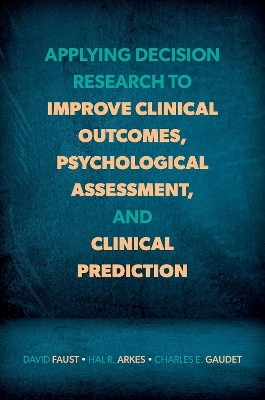
Applying Decision Research to Improve Clinical Outcomes, Psychological Assessment, and Clinical Prediction
Oxford University Press Inc (Verlag)
978-0-19-769423-7 (ISBN)
Applying Decision Research to Improve Clinical Outcomes, Psychological Assessment, and Clinical Prediction introduces graduate students and practitioners in the mental health field to research, knowledge, and practical strategies that can enhance diagnostic and predictive accuracy and thereby improve client care. Major chapters of the book address well-established, but often under-recognized, principles and procedures for improving the integration of clinical data and interpretive accuracy; the differentiation between seemingly accurate but illusory, as opposed to genuine, associations between signs, symptoms, and outcomes; and the minimization of impediments to accurate decision making. The authors merge applied clinical tasks in the mental health field with decision research and cognitive psychology to suggest ways in which prediction, diagnosis, and assessment can be accomplished with greater efficacy and precision.
David Faust, PhD is Professor, Department of Psychology and Fellow of the Ryan Institute of Neuroscience, University of Rhode Island; Affiliate Professor, Warren Alpert Medical School of Brown University, Department of Psychiatry and Human Behavior Hal R. Arkes, PhD is Emeritus Professor of Psychology, Ohio State University; Associate, Harding Center for Risk Literacy Charles E. Gaudet, PhD is Fellow, Department of Physical Medicine and Rehabilitation, Harvard Medical School, Massachusetts General Hospital, Spaulding Rehabilitation Hospital
Part I: Introduction and Foundations
Chapter 1 The Benefits of Decision Research for Clinical Practice: Framing the Issues
Chapter 2 Avoiding Unnecessary Error
Part II: Gathering, Appraising, and Integrating Information
Chapter 3 Assessing Whether Clinical Variables Are Related: The Important Task of Covariation Estimation
Chapter 4 Confirmation Bias
Chapter 5 Impediments to Accurate Decision Making
Chapter 6 Base Rates: One of the Diagnostician's and Prognosticator's Greatest Allies
Chapter 7 The Integration of Information: Strengths and Limits
Chapter 8 Comparing Clinical Judgment and Statistical Decision Methods
Chapter 9 Research on Racial/Ethnic Biases and Professional Judgment: Errors in Cold Cognition, Hot Cognition, and Interconnections with Decision Research
Chapter 10 The Use of Artificial Intelligence in Clinical Decision Making: Current Status, Potential Advantages and Limits, Future Prospects
Part III: Corrective Methods and Strategies
Chapter 11 Overconfidence and the Limits of Experience
Chapter 12 The Limits of Insight Alone; Need for Active Steps, and Use of Debiasing Strategies
Chapter 13 Approaches for Improving Information Gathering, Appraising the Utility of Information, and Combining and Interpreting Information
Appendices
Appendix 1 A sampling of base rate sources
Appendix 2 Base rate nomogram
Appendix 3 Examples of combining base rates with other diagnostic signs, indicators, and test results
Appendix 4 A sampling of recent publications in five areas of machine learning and artificial intelligence related to applied clinical practice
Appendix 5 Practice Cases and Clinical Scenarios
Appendix 6 Checklists/Guidelines
| Erscheinungsdatum | 25.04.2024 |
|---|---|
| Verlagsort | New York |
| Sprache | englisch |
| Maße | 157 x 235 mm |
| Gewicht | 572 g |
| Themenwelt | Geisteswissenschaften ► Psychologie ► Klinische Psychologie |
| Geisteswissenschaften ► Psychologie ► Test in der Psychologie | |
| ISBN-10 | 0-19-769423-3 / 0197694233 |
| ISBN-13 | 978-0-19-769423-7 / 9780197694237 |
| Zustand | Neuware |
| Informationen gemäß Produktsicherheitsverordnung (GPSR) | |
| Haben Sie eine Frage zum Produkt? |
aus dem Bereich


